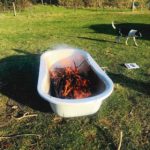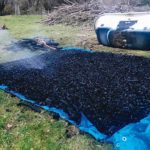How Dr Compost Ben Elms makes biochar in a bathtub (and how he uses biochar in the garden)
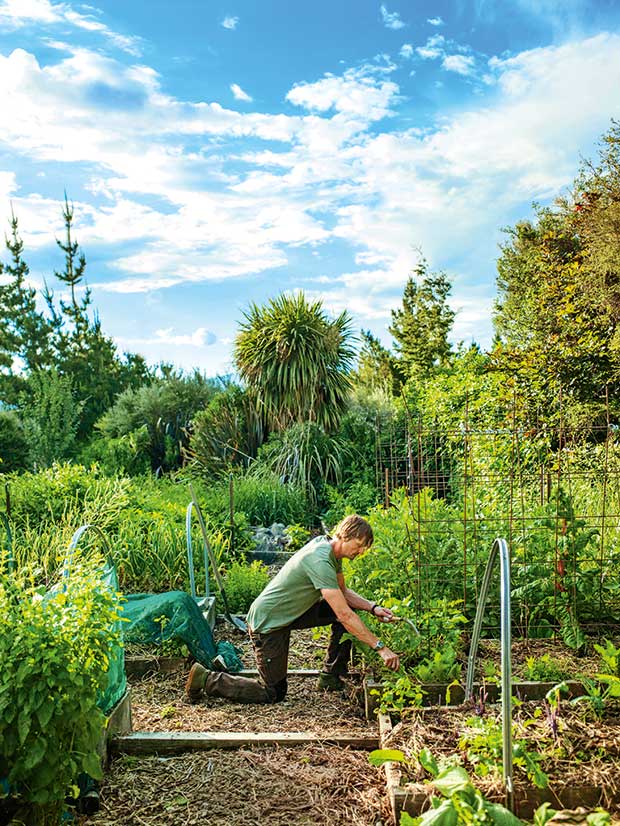
Ben Elms is an expert compost-maker. But his latest way to create better soil is by adding biochar, made in his new bespoke kiln.
Words & images: Ben Elms
I first read about the wonders of biochar about 10 years ago, but it was an idea I left smouldering on the back burner while I dug deep into compost-making and waste reduction.
Over the years I did dabble by taking charcoal out of the fire, or the dying charcoal embers out of a big burn pile.
I’d cool it, crumble it up and add it into our compost. Amounts were so negligible that I didn’t notice any effects.
My biochar mission was kicked into action by a workshop run by the local Tree Crops branch. Organic garden educator Josie Blackshaw (of Gardens Without Borders) enthusiastically taught us how to make biochar in an earth pit.
We danced around the fire and took home a bag of biochar.
At home, I put it into a bucket and happily peed on it every time I passed where it was sitting in the garden. Urine is a fantastic source of nutrients that you can use to ‘charge’ biochar. I’m still trying to persuade the rest of my family to pee in it. Good things take time.
The more I read about the benefits of biochar, the more I wanted to make large amounts out of the piles of waste wood I saw everywhere, not just a bit here and there.
You can buy bags of biochar from gardening stores, but the problem is, it comes from China. I don’t want to buy Chinese biochar. It doesn’t seem right that my soil benefits from somebody converting biomass to biochar on the other side of the world. And one of the main points is to reduce atmospheric carbon; think of the enormous amounts of carbon released to ship it here.
When I look around my lifestyle block, I see potential biochar everywhere: fruit tree and firewood prunings, pine brash, old pallets, broom, and so on. I’m guessing most lifestyle blocks have a pile like this.
This ‘waste wood’ used to get put into my yearly drink-good-whiskey-while-having-a-massive-bonfire pile, but now I see it as a resource.
There are many ways to make biochar. In my research, I discovered low-tech biochar kilns. I wanted one, badly.
I emailed the Ithaka Institute, a group world-renowned for their work and research into biochar. The institute has been pioneering low-tech biochar kiln design for the last decade and its kon-tiki kiln is popular all over the world.
They gave me the plans, and I asked a local engineer friend to build it, with a few modifications I’d seen online. While I was waiting for the kiln, I went on another course, part of a national tour to lift people’s awareness of biochar. It was run by two of New Zealand’s loudest and most proactive advocates, Dennis Enright and Trevor Richards.
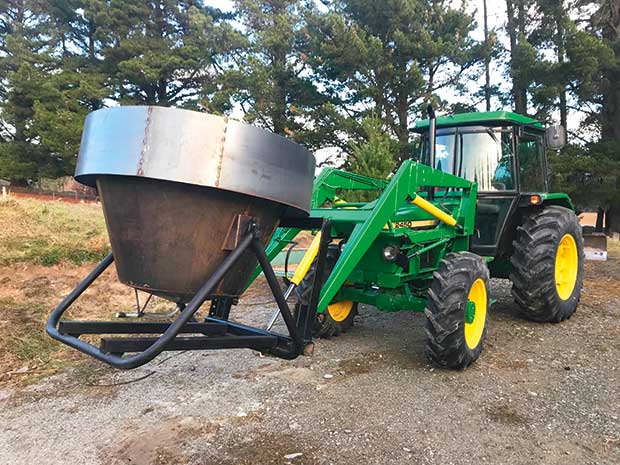
Ben Elms’ bespoke biochar kiln is moved around his block by tractor.
These men have been trying to get New Zealand to embrace biochar for many years, but both say it’s been a slow, uphill journey.
Dennis makes biochar in old steel baths. He has a 10 bath set-up in his garden.
It doesn’t get more low-tech or easier, so I started experimenting. I love steel bath kilns because:
• there’s no digging;
• they cost next to nothing;
• they are very easy to find;
• they are a good size;
• the burn time is a couple of hours from start to finish.
Imagine my excitement when my bespoke kon-tiki kiln arrived. One of the modifications allows me to slide tractor forks on either side of it so I can easily lift and move the kiln.
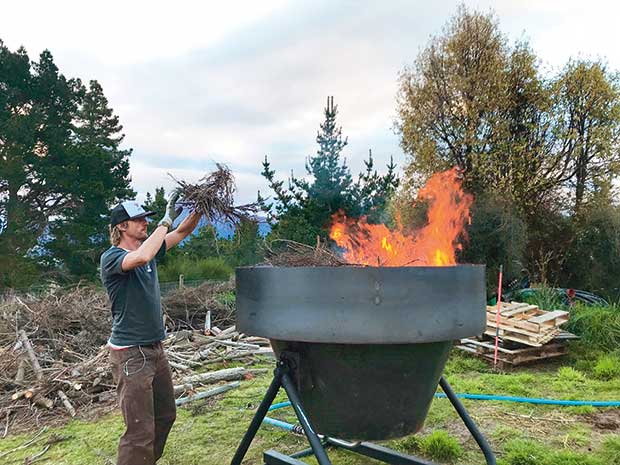
I can take the kiln to any woodpile, instead of lugging the wood to the kiln. I can also load it onto a trailer and lend it to friends.
The kon-tiki has a burn time of about five hours and produces just under a cubic metre of biochar.
We have a couple of water totes to deliver the final quenching of the burn. The kiln has a cleverly-placed pipe at the bottom. All we need to do is turn on the top water tote and the kiln fills up with water in about 15-20 minutes.
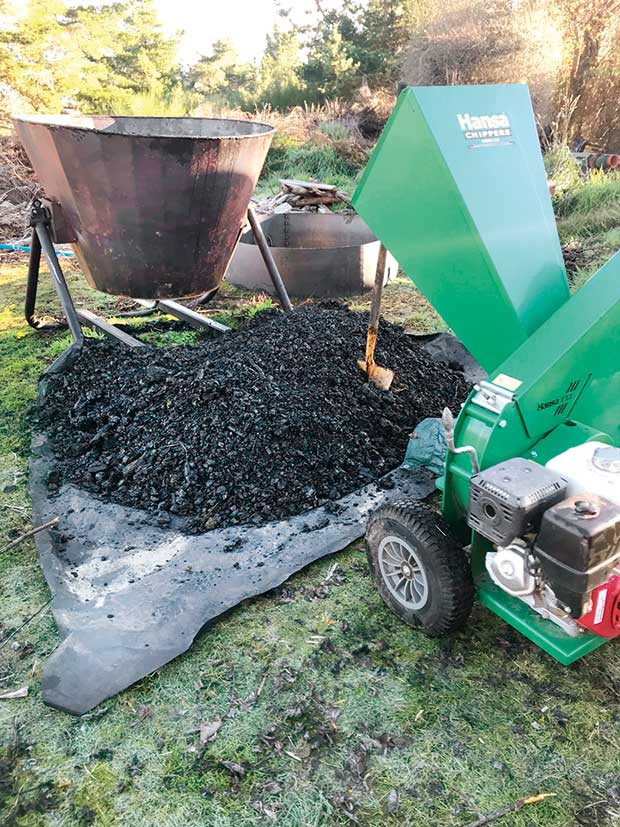
To avoid more work, I add liquid seaweed, liquid comfrey, nettle tea, or liquid chicken manure to the water tote. This extinguishes the biochar and charges it with nutrients at the same time.
Read more about the kon-tiki kiln:
The Ithaka Institute has more information on how to make a kiln. They only ask for a donation to help fund their work in return.
BEN’S EXPERIMENTS IN USING BIOCHAR
First, you need to break the biochar into smaller pieces. I’ve been using a Hansa wood chipper to do this, but it’s not perfect, and I fear for the wood chipper’s lifespan.
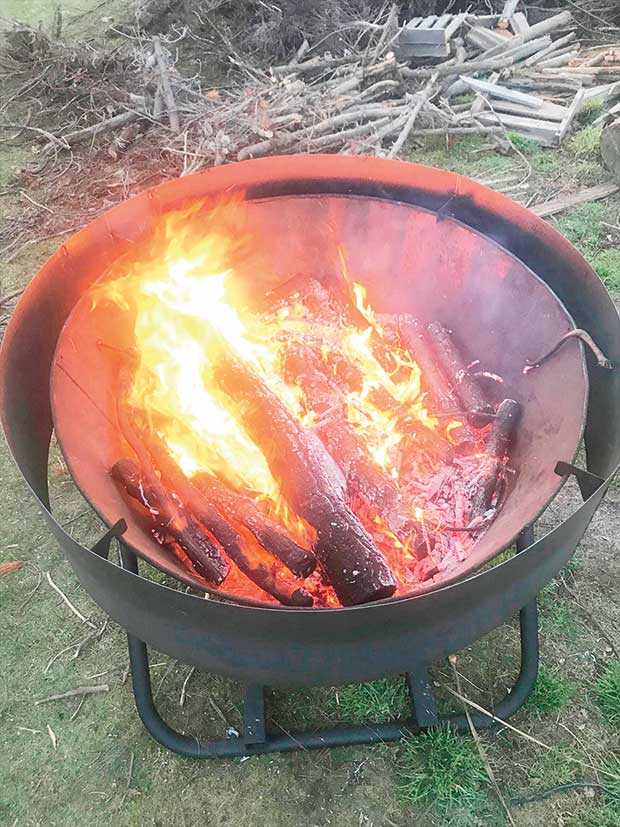
One very easy way to crush it is to throw 5-10cm chunks of biochar onto an old piece of plywood. I then put on a pair of sturdy boots or work boots, turn on some banging tunes, and start dancing. It’s surprisingly quick to break down but even quicker if you have friends to help you.
Making biochar in a bath
Using an old steel bath is an easy way to create the conditions you need for good biochar. Ben uses thin branches, leftover after pruning trees on his block.
The size of the bath means it only takes a couple of hours to complete a burn, and it’s easy to put the fire out at the end.
3 WAYS BEN USES BIOCHAR
1. Vegetable seedling potting mix
Ratio: 10% of the mix
You can find fantastic experiments online using potting mixes and different volumes of biochar. I aim for 10% in my homemade potting mix, but you could also add it to a commercially-bought product.
I’m also adding it to the potting mix I use for shrubs and trees.
2. Compost
Ratio: 10%+
Every compost heap I create gets a minimum of 10% biochar added to it. This way, it pre-charges itself. It’s also a great way to gradually apply biochar to the soil every time we add compost.
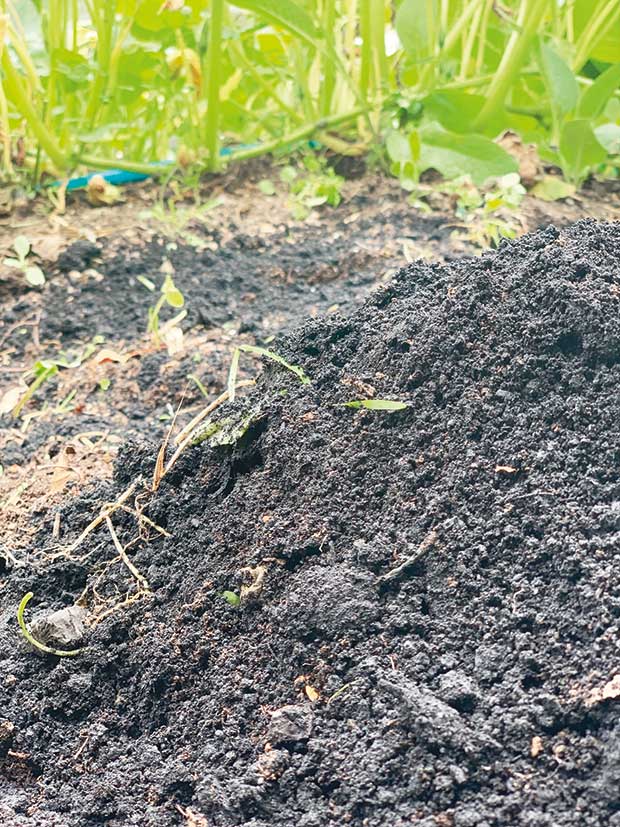
Compost and biochar about to be dug into a garden bed.
3. Vegetable beds
Ratio: 10% in the top 20cm
We plan to mix this into the soil directly, and every time I plant a seedling, but I haven’t made enough yet.
If we have a surplus, which I hope will be in the next few years, it will get dug in around fruit trees, and applied to lawns and paddocks.
5 WAYS TO ‘PRE-CHARGE’ BIOCHAR
Biochar isn’t a fertiliser. Its porosity makes it an effective carrier of nutrients, moisture (up to five times its own weight), and a great habitat for soil micro-organisms.
To get the best out of biochar you need to ‘pre-charge’ it, so it’s already soaked and holding nutrients. You can do this by:
1. Soaking the biochar in water, along with added nutrients, such as compost tea.
2. Adding biochar to high-quality compost at a ratio of 10%; it holds nutrients, increasing plant-availability of nitrate and preventing nitrogen-loss as gas, and lowering gas emissions as the compost ages.
3. Adding biochar to animal bedding.
4. Adding biochar to bokashi.
5. Adding biochar to a high-quality, high-mineral organic liquid fertiliser. Dissolving biochar in a mix of fertiliser and water, then leaving it for two days before spreading it, has been shown to reduce leaching and outgassing of nutrients. Biochar also increases fertiliser efficiency, meaning only half as much needs to be applied.
THE BIOCHAR NETWORK OF NEW ZEALAND
A growing number of New Zealanders, including farmers, forestry, horticulturists, lifestyle blockers, market gardeners and home gardeners, are becoming interested in making and using biochar.
This has led to the formation earlier this year of the Biochar Network New Zealand (BNNZ).
The BNNZ is planning to promote and support activities that provide widespread awareness, understanding, and acceptance of biochar in New Zealand.
The group hopes it will lead to a diverse range of production and application scenarios for the benefit
of New Zealand’s agriculture, industry, and environment.
Every person who joins will be helping to achieve the goals of BNNZ.
More information about biochar here.
Who: Ben Elms, ‘Dr Compost’
Where: Hawea, 20km north-east of Wanaka
Land: 20ha (50 acres)
What: compost educator, biochar-maker
MORE HERE:
Dr Compost Ben Elms’ recipe for a good life and tips for top compost
Love this story? Subscribe now!
 This article first appeared in NZ Lifestyle Block Magazine.
This article first appeared in NZ Lifestyle Block Magazine.
